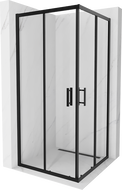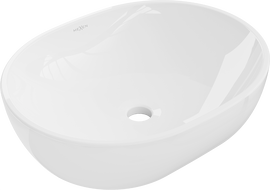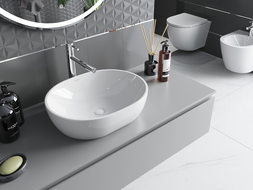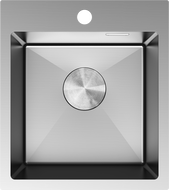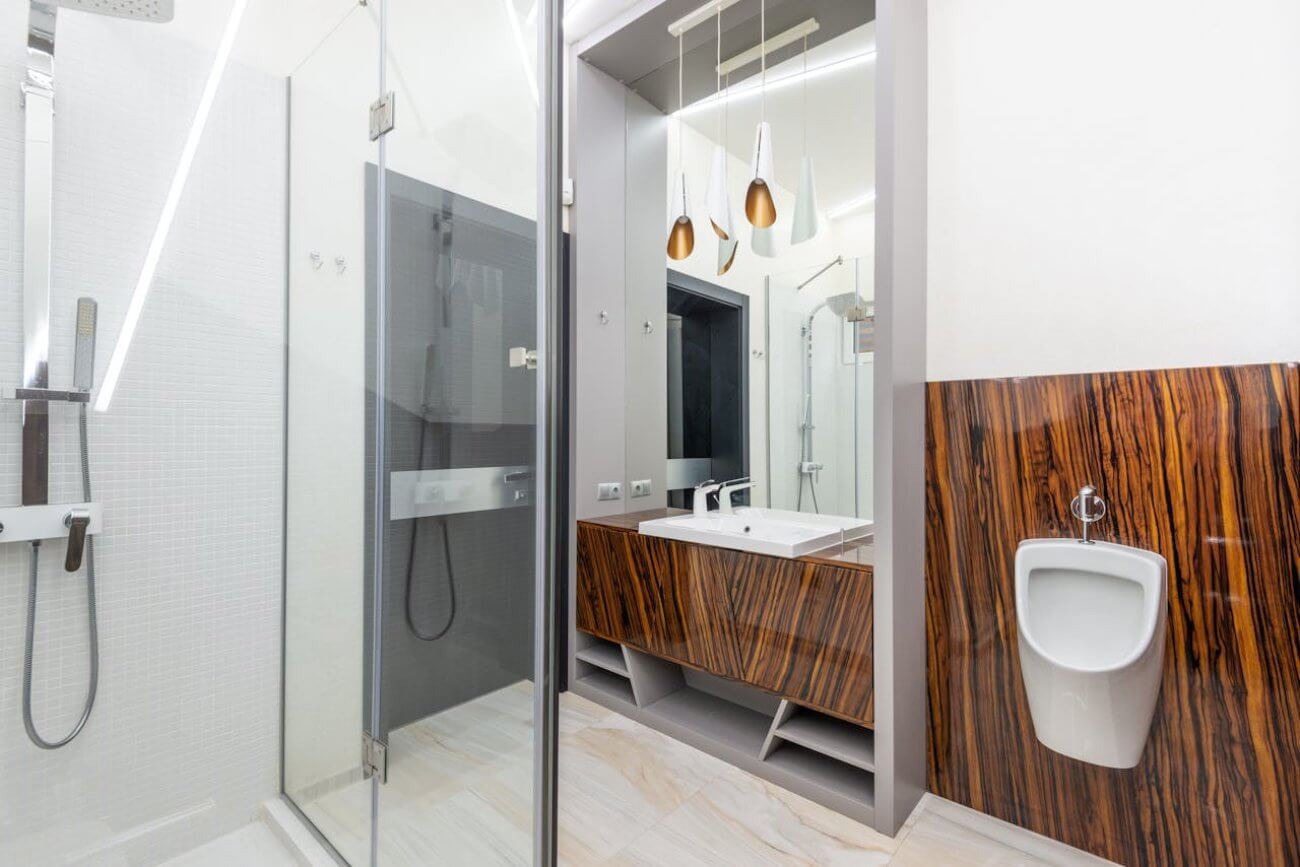
An urinal at home is a solution that is gaining increasing popularity year by year, especially in modern bathrooms. Although they are mainly associated with public toilets, they can also be found in private bathrooms. Read today about the benefits of this solution. Discover the advantages of this specific sanitary facility. Check whether it is worth deciding to install a urinal in your home toilet?
What Will You Learn from This Article?
Are you wondering if a urinal at home is really a functional option? In this article, you will discover the benefits of installing this ceramic in your home bathroom and how to choose the best model for yourself. You will also learn:
- What are the advantages of having a urinal at home?
- What types of urinals can be distinguished?
- How to properly install this ceramic so it works flawlessly?
- What should be considered when choosing a urinal?
With this information, you will make an informed decision and learn how to maximize the potential of this modern sanitary facility.
Urinal at Home – Practical and Economical
The decision to install a urinal at home is often an individual matter. Initially, attention should be paid to several important issues that speak in favor of this bathroom ceramic. First of all, it takes up little space, which means it can be installed even in small areas. It should be noted that the available urinal models on the market are designed with functionality and aesthetics in mind.
Urinals in private homes are usually mounted directly on the wall, making them ideal for any bathroom. Thanks to their special construction, they are easy to clean, which definitely facilitates daily use. It is also worth noting the water savings offered by modern urinals. Compared to traditional toilets, they use significantly less water during flushing, which directly translates to lower bills.
Wall-Mounted Urinals and More – Discover the Types of Urinals!
There are many types of urinals available on the market, differing in both functionality and design. One of the most popular solutions is the classic wall-mounted urinals, which are designed for direct wall installation. They take up little space and are perfect for public toilets with higher traffic.
Column urinals are also often chosen, which are more stable and can elegantly complement the space in a home bathroom. Additionally, corner models and urinals with a touchless flushing function are becoming increasingly common.
This specific bathroom ceramic can also be chosen based on water supply and cleaning method. Traditional variants are equipped with a manual button, but modern, waterless urinals are also available, eliminating the need for flushing. This is not only an ecological but also hygienic solution that minimizes the risk of contact with bacteria, while providing easy cleaning.
There are also models with intelligent sensors that automatically trigger the flushing after use. Thus, choosing the right urinal depends on both the user's preferences and the specifics of the bathroom.
Which Urinal to Choose?
The best choice for a home bathroom will be a urinal that combines functionality with aesthetics and adapts to the individual needs of users. First, check the installation method – urinals can be installed in various ways, and the right choice primarily depends on the room layout and aesthetic preferences.
Secondly, the material used in the manufacturing process is important. A standard urinal can be made from various materials, such as ceramic or stainless steel. It is also important to consider additional features such as height adjustment or built-in water-saving systems.
Installing a Urinal in the Bathroom – What You Should Know?
Installing a urinal at home is a relatively simple process, but it requires proper preparation and planning. Typically, it is mounted on the wall at a height of 60 to 80 cm from the floor. It is also important to ensure the appropriate distance from other sanitary fixtures, such as sinks or toilets, to ensure comfort while using the bathroom. Additionally, its appearance is essential; for example, models with a streamlined shape are best for small spaces in private bathrooms.
Installing a urinal requires connecting it to the water and sewage system, similar to a traditional toilet. Modern variants, like those offered by Mexen, are equipped with a special siphon and flushing system, ensuring proper waste disposal.
In the case of a waterless urinal, installation is even simpler, as its construction does not require connection to water.
Therefore, to install a urinal you will need:
- siphon,
- flushing mechanism,
- sewage outlet,
- water connections,
- installation kit (anchors, screws),
- seals.

Is a Urinal at Home a Good Idea?
A urinal at home is definitely an investment that brings many benefits. First of all, it is a very hygienic solution. Thanks to its special construction, the urine stream flows directly to the drain, minimizing the risk of splashing liquids on other elements in the bathroom.
Water savings is another advantage that speaks in favor of installing a urinal at home. Compared to a traditional toilet, which uses about 6-9 liters per flush, a urinal only needs 1-2 liters of water. This means using a urinal is incredibly eco-friendly.
Urinal as a Functional Element of the Bathroom
A good quality urinal can also become a unique element of a modern bathroom. Thanks to its minimalist design and ability to adapt to various interior styles, it fits practically into all bathrooms. It is an extremely hygienic sanitary fixture.
Moreover, urinals in home bathrooms are distinguished by their practicality, especially when there are more residents. They facilitate toilet use, especially during morning rush hours when access to the toilet is most desirable, particularly in homes with several men.
Urinals can also be a convenient solution for guest bathrooms, offering many advantages, including added functionality and hygiene.
Installing a Urinal at Home – Is It Complicated?
Installing a urinal is not a complicated task, but it is worth considering what exactly affects its proper functioning. First of all, it is necessary to properly prepare the water and sewage installation and ensure that the urinal is installed at the correct height. Of course, regular cleaning of this sanitary device is also necessary to ensure long-lasting and hygienic use.
Installing a Urinal on the Wall – Learn About the Procedure!
- Prepare the Wall – designate the location where to attach the ceramic, check if it is straight!
- Install the Drain – connect the urinal to the sewage system.
- Install the Water Connections – connect the flushing valve to the water supply.
- Secure the Urinal – fix the ceramic to the wall using anchors and screws.
- Connect the Siphon – connect the siphon to the drain.
- Perform a Flushing Test – check the tightness and operation of the flushing system.
- Finish the Ceramic – seal the urinal or adjust its installation.
A urinal at home is also an investment in the future. Its ease of cleaning is one of its biggest advantages. Unlike traditional toilets, it significantly reduces the risk of spreading bacteria and unpleasant odors, thanks to its ergonomic mechanisms.
Many urinal models are equipped with advanced flushing systems that provide effective surface cleaning, which reduces the need for frequent washing and using aggressive cleaning agents.
Is It Worth Having a Urinal in the Bathroom?
When choosing a urinal, it is worth considering its advantages, which can significantly impact the functionality and comfort of daily use. A urinal not only contributes to optimizing space, but also uses less water. Additionally, thanks to modern technologies, it ensures cleanliness in every home.
Furthermore, a urinal is easy to install and maintain, making it an excellent choice for both large public bathrooms and small home toilets. It is also important to remember that an aesthetically chosen urinal can serve as a modern element of interior design, adding elegance and functionality to the space.

